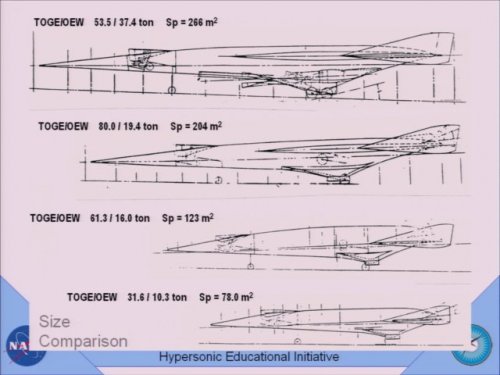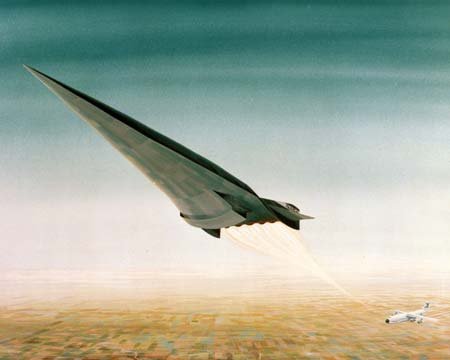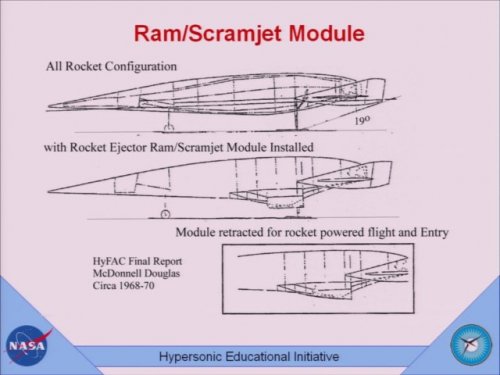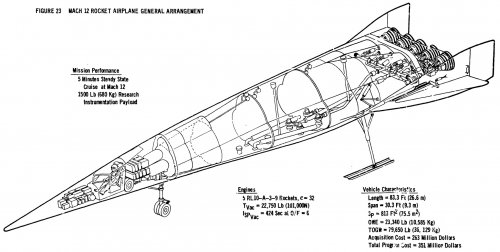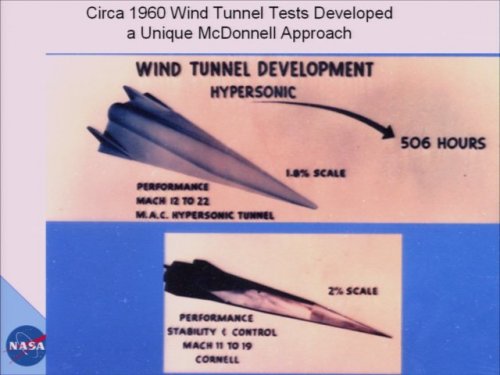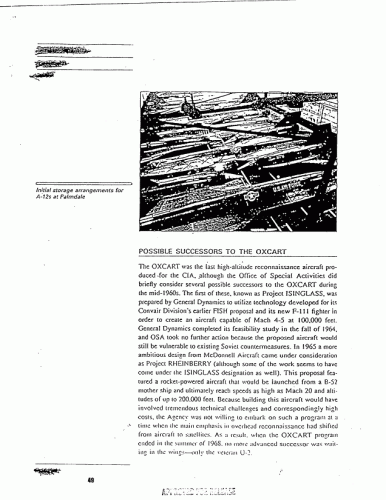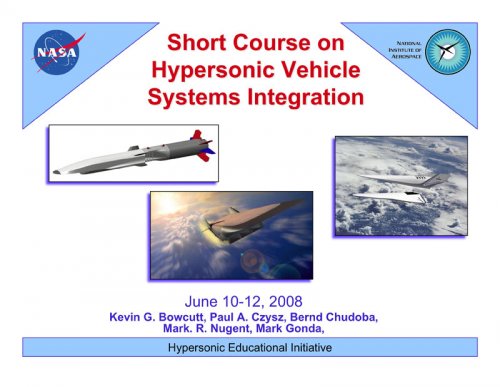You are using an out of date browser. It may not display this or other websites correctly.
You should upgrade or use an alternative browser.
You should upgrade or use an alternative browser.
Project ISINGLASS & Project RHEINBERRY
- Thread starter flateric
- Start date
- Joined
- 29 July 2009
- Messages
- 1,756
- Reaction score
- 2,410
The NASA B-52H on loan from the USAF will be augmented to carry a 70,000 lb pylon mounted payload as per the article below:
http://www.dfrc.nasa.gov/Newsroom/X-Press/stories/083101/new_b52.html
The smallest vehicle in the PC lecture was 63,200 lb (31.6t) TOGW. I don't know if the NB-52A/B could be modified for that weight, but the B-52H, built in 1965, is apparently capable of supporting this payload. Its about a 20% increase over the X-15 No.2 vehicle.
Also, the vehicle is shown flying from a C-5. The plan may have been to fly the smallest vehicle from the B-52 and a growth version from the C-5 or possibly that the aircraft design weight grew too large for the B-52 and was switched to a C-5.
Notice both the "All Rocket" version and the "Modular Ramjet/Scramjet" versions have skids. This slide represents the smallest versions of the HYFAC vehicles, which may have been test articles for ISINGLASS. None have the XLR-129 engine(s), until the HSVS vehicle. PC also says that earlier design work and models were destroyed and that the data fed the next version (i.e. the black model with one, very large XLR-129).
http://www.dfrc.nasa.gov/Newsroom/X-Press/stories/083101/new_b52.html
The smallest vehicle in the PC lecture was 63,200 lb (31.6t) TOGW. I don't know if the NB-52A/B could be modified for that weight, but the B-52H, built in 1965, is apparently capable of supporting this payload. Its about a 20% increase over the X-15 No.2 vehicle.
Also, the vehicle is shown flying from a C-5. The plan may have been to fly the smallest vehicle from the B-52 and a growth version from the C-5 or possibly that the aircraft design weight grew too large for the B-52 and was switched to a C-5.
Notice both the "All Rocket" version and the "Modular Ramjet/Scramjet" versions have skids. This slide represents the smallest versions of the HYFAC vehicles, which may have been test articles for ISINGLASS. None have the XLR-129 engine(s), until the HSVS vehicle. PC also says that earlier design work and models were destroyed and that the data fed the next version (i.e. the black model with one, very large XLR-129).
Attachments
XP67_Moonbat
ACCESS: Top Secret
- Joined
- 16 January 2008
- Messages
- 2,270
- Reaction score
- 530
Dyno,
I'd buy you some beers right now.
Moonbat
I'd buy you some beers right now.
Moonbat
- Joined
- 26 September 2008
- Messages
- 1,960
- Reaction score
- 738
Dynoman said:Notice both the "All Rocket" version and the "Modular Ramjet/Scramjet" versions have skids. This slide represents the smallest versions of the HYFAC vehicles, which may have been test articles for ISINGLASS. None have the XLR-129 engine(s), until the HSVS vehicle. PC also says that earlier design work and models were destroyed and that the data fed the next version (i.e. the black model with one, very large XLR-129).
You have to check the chronology there. ISINGLASS was conceived in 1964 or early 1965 and was stone cold dead by 1968. Your slide shows a date _after_ that, so it could not have fed into ISINGLASS.
By the way, somebody just contacted me with some more info regarding ISINGLASS and said that apparently the vehicle was technically feasible, but that they could not turn it into a recon vehicle because the shockwave made it impossible to use optics. He is a former agency guy who got this directly from one of the CIA program managers back in the 1980s (guy had overseen it in the 1960s).
shockonlip
ACCESS: Top Secret
- Joined
- 29 January 2008
- Messages
- 605
- Reaction score
- 54
Dynoman,
One can find top, side, and cross sectional views of the vehicles in your first slide in:
"Scramjet Propulsion"
Edited by: Curran amd Murthy
Chapter 16: "Transatmospheric Launcher Sizing" by Czysz and Vandenkerckhove
See pg 1050 for essentially Paul's slide.
The sequence I described above starts at: pg 1098
You will recognize many things Paul talked about.
One can find top, side, and cross sectional views of the vehicles in your first slide in:
"Scramjet Propulsion"
Edited by: Curran amd Murthy
Chapter 16: "Transatmospheric Launcher Sizing" by Czysz and Vandenkerckhove
See pg 1050 for essentially Paul's slide.
The sequence I described above starts at: pg 1098
You will recognize many things Paul talked about.
XP67_Moonbat
ACCESS: Top Secret
- Joined
- 16 January 2008
- Messages
- 2,270
- Reaction score
- 530
With the C-5 launched variant, I knew something was up.
- Joined
- 6 August 2007
- Messages
- 3,853
- Reaction score
- 5,730
blackstar said:By the way, somebody just contacted me with some more info regarding ISINGLASS and said that apparently the vehicle was technically feasible, but that they could not turn it into a recon vehicle because the shockwave made it impossible to use optics. He is a former agency guy who got this directly from one of the CIA program managers back in the 1980s (guy had overseen it in the 1960s).
There were some advancements in this area in the mid 80s, though not directly connected to ISINGLASS of course. People were still working the problem. By that time though, attention focused to using a radar.
What is curious to me is that few of these drawings, and the model, show the two position XLR-129 nozzle
shockonlip
ACCESS: Top Secret
- Joined
- 29 January 2008
- Messages
- 605
- Reaction score
- 54
XP67_Moonbat said:With the C-5 launched variant, I knew something was up.
Moonbat, remember Paul was talking about MOL not ISINGLASS.
C-5 didn't first fly until the late 1960's, from what I recall.
XP67_Moonbat
ACCESS: Top Secret
- Joined
- 16 January 2008
- Messages
- 2,270
- Reaction score
- 530
true
Of course, the shockwave interference with optics isn't a problem if your trajectory takes you into the near-vacuum of space. Pop off some photos once you're 62+ miles above the area of interest. It certainly kills your resolution and limits your dwell time, of course.
CFE said:Of course, the shockwave interference with optics isn't a problem if your trajectory takes you into the near-vacuum of space. Pop off some photos once you're 62+ miles above the area of interest. It certainly kills your resolution and limits your dwell time, of course.
Alternatively, chuck your camera overboard. Attach it to a good, stable aerodynamic decellerator; it slows way the hell down, drops like a stone, takes its photos, radios the message to the spaceplane (or overhead satellite), and self-destructs.
Expensive as hell, but possibly workable. If the cameras are small enough, the individual housings could be like miniature CAVs, and could drop quite low. An off-the-shelf digital camera with some commercial optics might not do half bad at Mach 1 and 25,000 feet over the target.
- Joined
- 29 July 2009
- Messages
- 1,756
- Reaction score
- 2,410
Shocklip...you are right in that the operational version of the C-5 didn't fly until March of 1968, however design work started in 1961 on the CX-HLS with a contract awarded to Lockheed in September of 1965 for the C-5A. PC says in the video that the initial work began with the heavier vehicles and that "Dick Peterson and Tom Gregory" thought the designs were too heavy.
PC says during the HEI Vehicle Systems Day 2 video at 01:03:05 that they (MAC) proposed a lighter version to be airlaunched from a C-5! This is part of his discussion on Global Range glider.
Note also that the vehicle launching from the C-5 and the notional Mach 12 demonstrator have five engines abreast (counting the exhaust plumes from the C-5 Launch picture). And that he points out in the video that "this is the vehicle that would launch from a C-5" having to modify the outboard engine pylon/nacelle to incorporate the air launched vehicle on its pylon.
PC says during the HEI Vehicle Systems Day 2 video at 01:03:05 that they (MAC) proposed a lighter version to be airlaunched from a C-5! This is part of his discussion on Global Range glider.
Note also that the vehicle launching from the C-5 and the notional Mach 12 demonstrator have five engines abreast (counting the exhaust plumes from the C-5 Launch picture). And that he points out in the video that "this is the vehicle that would launch from a C-5" having to modify the outboard engine pylon/nacelle to incorporate the air launched vehicle on its pylon.
Attachments
- Joined
- 1 April 2006
- Messages
- 11,346
- Reaction score
- 10,030
Marco, any luck with downloading HEI lectures so far?
I'm not considering myself a complete idiot when dealing with PC, but so far all my efforts with Silverlight tech realtime media downloaders are complete fiasco...which one do you use?
I'm not considering myself a complete idiot when dealing with PC, but so far all my efforts with Silverlight tech realtime media downloaders are complete fiasco...which one do you use?
XP67_Moonbat
ACCESS: Top Secret
- Joined
- 16 January 2008
- Messages
- 2,270
- Reaction score
- 530
Dyno,
I too, noticed that the M.12 demonstrator and the artwork both have five abreast engines.
I too, noticed that the M.12 demonstrator and the artwork both have five abreast engines.
- Joined
- 29 July 2009
- Messages
- 1,756
- Reaction score
- 2,410
Moonbat...I agree. What is strange to me is why the picture has what looks like "NASA" on the vertical stabilizer. Was the plan to cover-up the test launches similar to the "NASA weather flights of the U-2" or to pitch the aircraft to NASA? Very confusing :-\
Also interesting to note is that PC indicates that two models were developed, what he remembers as just before 1960, that were associated with a highly classified program, and were later destroyed. These are the two models below. The bottom model looks alot like the Mach 12 demonstrator in planform and configuration. This may have been Model 192. Does anyone have a chronological list of MAC model designations and could isolate the date of Model 192?
Also interesting to note is that PC indicates that two models were developed, what he remembers as just before 1960, that were associated with a highly classified program, and were later destroyed. These are the two models below. The bottom model looks alot like the Mach 12 demonstrator in planform and configuration. This may have been Model 192. Does anyone have a chronological list of MAC model designations and could isolate the date of Model 192?
Attachments
XP67_Moonbat
ACCESS: Top Secret
- Joined
- 16 January 2008
- Messages
- 2,270
- Reaction score
- 530
I don't. But I bet HyperTech could answer that.
In the meantime, I found an HEI presentation PDF. It's the last of 11 such briefs. Brief #1 is not found, oddly enough.
Here you go: http://research.nianet.org/~grossman/Fundamentals/Hypersonic%20Systems%20Integration/11-HEI%20SysIntegration.pdf
I couldn't find anything actually ISINGLASS-related like in Dyno's post. But here's brief #4. It's got some stuff from one of Professor C's earlier presentations tossed in.
http://research.nianet.org/~grossman/Fundamentals/Hypersonic%20Systems%20Integration/4-HEI%20SysIntegration.pdf
In the meantime, I found an HEI presentation PDF. It's the last of 11 such briefs. Brief #1 is not found, oddly enough.
Here you go: http://research.nianet.org/~grossman/Fundamentals/Hypersonic%20Systems%20Integration/11-HEI%20SysIntegration.pdf
I couldn't find anything actually ISINGLASS-related like in Dyno's post. But here's brief #4. It's got some stuff from one of Professor C's earlier presentations tossed in.
http://research.nianet.org/~grossman/Fundamentals/Hypersonic%20Systems%20Integration/4-HEI%20SysIntegration.pdf
- Joined
- 17 October 2006
- Messages
- 2,393
- Reaction score
- 1,191
BlackStar - I think the shockwave story is in The Wizards of Langley, by Richelson.
- Joined
- 26 September 2008
- Messages
- 1,960
- Reaction score
- 738
LowObservable said:BlackStar - I think the shockwave story is in The Wizards of Langley, by Richelson.
Yeah, it is. Apparently he and I heard it from the same person.
- Joined
- 29 July 2009
- Messages
- 1,756
- Reaction score
- 2,410
Blackstar, I'm wondering if any additional data on hypersonic optical cameras and windows are available. I've read that the X-15 experimented with these issues and that the photographic data was remarkable. The tests were done in 1963 on X-15-2, flying around Mach 5 and over 140,000 ft. This information can be found in "Progress of the X-15 Research Airplane" dated 1965, on NASA's tech server.
Also, this section on X-15 reconnaissance systems tests, from the link below:
"4) Aerial Photographs. Optical degradation experiments determined that the shock wave, boundary-layer flow, and temperature gradients across windows caused negligible degradation to visual, near-IR, and radar aerial photography to Mach 5.5 and 125,000 feet. However, improved photographic equipment and much faster-speed films may very well invalidate these findings, hence the need for renewed flight testing. Toward the end of this experiment several tests of near-IR color photography produced the first successful inflight use of color films. Such were later used in reconnaissance work over Southeast Asia where colored emissions could denote enemy activity under dense foliage. ERDA now uses this technique via satellites to study the earth's resources."
http://history.nasa.gov/hyperrev-x15/ch-7.html
I've also read that over Mach 6 the thermal-thicket becomes a much more difficult problem. I'm wondering if ISINGLASS would be high enough in its profile, over the target, so that a retractable shield over the optical sensor window could be used, without significant effects.
Also, this section on X-15 reconnaissance systems tests, from the link below:
"4) Aerial Photographs. Optical degradation experiments determined that the shock wave, boundary-layer flow, and temperature gradients across windows caused negligible degradation to visual, near-IR, and radar aerial photography to Mach 5.5 and 125,000 feet. However, improved photographic equipment and much faster-speed films may very well invalidate these findings, hence the need for renewed flight testing. Toward the end of this experiment several tests of near-IR color photography produced the first successful inflight use of color films. Such were later used in reconnaissance work over Southeast Asia where colored emissions could denote enemy activity under dense foliage. ERDA now uses this technique via satellites to study the earth's resources."
http://history.nasa.gov/hyperrev-x15/ch-7.html
I've also read that over Mach 6 the thermal-thicket becomes a much more difficult problem. I'm wondering if ISINGLASS would be high enough in its profile, over the target, so that a retractable shield over the optical sensor window could be used, without significant effects.
- Joined
- 26 September 2008
- Messages
- 1,960
- Reaction score
- 738
Well, ISINGLASS was intended to fly _much_ faster than the X-15, Mach 22 versus Mach 5.
As for the issue of a retractable cover, the person who contacted me specifically referred to that in his message. He said that the program manager said that the problem was that the opening in the vehicle resulted in a small amount of ingestion of the airflow and shockwaves inside the camera compartment. End result was the same. (I'm paraphrasing because I read the message yesterday and didn't just look at it again.) I've asked him for further information on the ISINGLASS.
I still have quite a few documents on the program, some of which I posted to the www.nasaspaceflight.com website and which somebody re-posted here last year. I think I scanned in about 1/3 to half of what I have. I have not gone through them closely, but the majority of them are programmatic, with only limited discussion of technical issues. My suspicion is that although CIA is not opposed to declassification of ISINGLASS, they a) have made no special effort to declassify records regarding it, and b) in their normal declassification activity they have not yet gotten to the bulk of ISINGLASS records.* My goal is to take the article that I just ran on TSR and expand it using my other material and publish it in Spaceflight magazine. I'll probably ask Giuseppe to illustrate it.
The Wikipedia entry for this program is still a mess. General Dynamics didn't work on the vehicle, and it had no connection to FISH or KINGFISH. It was a McD project all along. I'll have to go correct that.
*The CIA has a project to declassify certain records. From my long experience with this process it is clear that there is no systemic approach to their declassification, they are simply working down the shelves in some classified warehouse. So my guess is that eventually they'll reach a shelf containing the retired records of somebody who oversaw the ISINGLASS program and start declassifying them and eventually we'll suddenly get a big influx of material. I've seen that happen before. Several years ago I suddenly started seeing a bunch of records that were obviously part of Richard Bissell's files, which included a couple of very interesting documents that linked Bissell to the concept of "freedom of space" (i.e. freedom of overflight) that Stephen Ambrose, Walter McDougall, Cargill Hall, Mike Neufeld and myself have all written about over the years.
As for the issue of a retractable cover, the person who contacted me specifically referred to that in his message. He said that the program manager said that the problem was that the opening in the vehicle resulted in a small amount of ingestion of the airflow and shockwaves inside the camera compartment. End result was the same. (I'm paraphrasing because I read the message yesterday and didn't just look at it again.) I've asked him for further information on the ISINGLASS.
I still have quite a few documents on the program, some of which I posted to the www.nasaspaceflight.com website and which somebody re-posted here last year. I think I scanned in about 1/3 to half of what I have. I have not gone through them closely, but the majority of them are programmatic, with only limited discussion of technical issues. My suspicion is that although CIA is not opposed to declassification of ISINGLASS, they a) have made no special effort to declassify records regarding it, and b) in their normal declassification activity they have not yet gotten to the bulk of ISINGLASS records.* My goal is to take the article that I just ran on TSR and expand it using my other material and publish it in Spaceflight magazine. I'll probably ask Giuseppe to illustrate it.
The Wikipedia entry for this program is still a mess. General Dynamics didn't work on the vehicle, and it had no connection to FISH or KINGFISH. It was a McD project all along. I'll have to go correct that.
*The CIA has a project to declassify certain records. From my long experience with this process it is clear that there is no systemic approach to their declassification, they are simply working down the shelves in some classified warehouse. So my guess is that eventually they'll reach a shelf containing the retired records of somebody who oversaw the ISINGLASS program and start declassifying them and eventually we'll suddenly get a big influx of material. I've seen that happen before. Several years ago I suddenly started seeing a bunch of records that were obviously part of Richard Bissell's files, which included a couple of very interesting documents that linked Bissell to the concept of "freedom of space" (i.e. freedom of overflight) that Stephen Ambrose, Walter McDougall, Cargill Hall, Mike Neufeld and myself have all written about over the years.
- Joined
- 29 July 2009
- Messages
- 1,756
- Reaction score
- 2,410
I'm looking forward to the article Blackstar! The optical distortion and window integrity would certainly be linchpins in the programs' success. The General Dynamics/Convair references must have eminated from the CIA document "The U-2's Intended Successor: Project Oxcart 1956-1968" page 40.
I've reproduced the page below. It states that GD's Convair division worked on a proposal that took technologies from FISH and the F-111 (assuming they mean its variable geometry wings) and created a Mach 4-5, 100,000 ft recon aircraft. I've spoken with a sizing specialist from Convair and he believes the design work may have been done in Fort Worth, TX, however, I haven't seen or read any confirmations of this.
I've reproduced the page below. It states that GD's Convair division worked on a proposal that took technologies from FISH and the F-111 (assuming they mean its variable geometry wings) and created a Mach 4-5, 100,000 ft recon aircraft. I've spoken with a sizing specialist from Convair and he believes the design work may have been done in Fort Worth, TX, however, I haven't seen or read any confirmations of this.
Attachments
XP67_Moonbat
ACCESS: Top Secret
- Joined
- 16 January 2008
- Messages
- 2,270
- Reaction score
- 530
Beat me to it! 
Well, here's link anyway:
http://www.paperlessarchives.com/a12.html
As far as using F-111 tech, could that be interpreted to mean swing-wings for low speed approaches? If so, maybe GD was brought in to consult on that aspect of ISINGLASS
It just a theory.
Moonbat
Well, here's link anyway:
http://www.paperlessarchives.com/a12.html
As far as using F-111 tech, could that be interpreted to mean swing-wings for low speed approaches? If so, maybe GD was brought in to consult on that aspect of ISINGLASS
It just a theory.
Moonbat
- Joined
- 29 July 2009
- Messages
- 1,756
- Reaction score
- 2,410
Moonbat...I found a good history of Convair and GD.
http://www.centennialofflight.gov/essay/Aerospace/convair/Aero36.htm
Convair became a division of GD in 1954. I suspect that after loosing Super Hustler and FISH, and later Kingfisher to Lockheeds A-12, that they were attempting to stay in the manned reconnaissnace game with the ISINGLASS. My theory is that they proposed something that looks like the VL-3A, which can be found elsewhere on Secret Projects.
http://www.centennialofflight.gov/essay/Aerospace/convair/Aero36.htm
Convair became a division of GD in 1954. I suspect that after loosing Super Hustler and FISH, and later Kingfisher to Lockheeds A-12, that they were attempting to stay in the manned reconnaissnace game with the ISINGLASS. My theory is that they proposed something that looks like the VL-3A, which can be found elsewhere on Secret Projects.
shockonlip
ACCESS: Top Secret
- Joined
- 29 January 2008
- Messages
- 605
- Reaction score
- 54
Dynoman said:Shocklip...you are right in that the operational version of the C-5 didn't fly until March of 1968, however design work started in 1961 on the CX-HLS with a contract awarded to Lockheed in September of 1965 for the C-5A. PC says in the video that the initial work began with the heavier vehicles and that "Dick Peterson and Tom Gregory" thought the designs were too heavy.
PC says during the HEI Vehicle Systems Day 2 video at 01:03:05 that they (MAC) proposed a lighter version to be airlaunched from a C-5! This is part of his discussion on Global Range glider.
Note also that the vehicle launching from the C-5 and the notional Mach 12 demonstrator have five engines abreast (counting the exhaust plumes from the C-5 Launch picture). And that he points out in the video that "this is the vehicle that would launch from a C-5" having to modify the outboard engine pylon/nacelle to incorporate the air launched vehicle on its pylon.
Hi Dynoman.
I don't believe that Paul was discussing ISINGLASS at all, except for a few jabs at 'classified' shapes and
then it isn't clear what program he 'might' have been talking about, with such references, as MOL was
very classified as well. I'm sure there were others as well.
Remember that ISINGLASS was gone by the late 60's, from what we currently know.
Paul was explicit that he was talking about a vehicle for support of the MOL mission.
C-5A could have been in the mix for the 1970's.
An interesting question is, is it up to Paul to disclose ISINGLASS?
I have not heard Paul announce anything new about ISINGLASS.
Therefore, ... .
And if it is not up to Paul to disclose it, he won't!
I'm sure he may be waiting for the disclosures himself.
I am quite sure that as more disclosures become available, he will have
quite a few interesting anecdotes.
>" having to modify the outboard engine pylon/nacelle to incorporate the air launched vehicle on its pylon. "
Outboard pylon?
- Joined
- 26 September 2008
- Messages
- 1,960
- Reaction score
- 738
Dynoman said:The General Dynamics/Convair references must have eminated from the CIA document "The U-2's Intended Successor: Project Oxcart 1956-1968" page 40.
I've reproduced the page below. It states that GD's Convair division worked on a proposal that took technologies from FISH and the F-111 (assuming they mean its variable geometry wings) and created a Mach 4-5, 100,000 ft recon aircraft. I've spoken with a sizing specialist from Convair and he believes the design work may have been done in Fort Worth, TX, however, I haven't seen or read any confirmations of this.
Yeah, that's apparently where it is from, but it's wrong. The writer must have made a mistake. The interview I have, plus the other documents, indicate that ISINGLASS was a McD project, not GD. GD may have been working on something of its own, but ISINGLASS was not it.
Dynoman said:The NASA B-52H on loan from the USAF will be augmented to carry a 70,000 lb pylon mounted payload as per the article below:
http://www.dfrc.nasa.gov/Newsroom/X-Press/stories/083101/new_b52.html
The smallest vehicle in the PC lecture was 63,200 lb (31.6t) TOGW. I don't know if the NB-52A/B could be modified for that weight, but the B-52H, built in 1965, is apparently capable of supporting this payload. Its about a 20% increase over the X-15 No.2 vehicle.
Unfortunately, this was in the day when NASA's NGLT at MSFC had the X-43B (TBCC & RBCC variants) and the X-43C (along with the USAF HyTech scramjet with a new NASA variable geometry inlet) programs in the works. These were the next programs slated to use the H-model and were looked at to fund the wing mod/pylon. When these programs went away, so did the funding source. I don't believe the mods/pylon were ever done.
XP67_Moonbat said:In the meantime, I found an HEI presentation PDF. It's the last of 11 such briefs. Brief #1 is not found, oddly enough.
Here you go: http://research.nianet.org/~grossman/Fundamentals/Hypersonic%20Systems%20Integration/11-HEI%20SysIntegration.pdf
I couldn't find anything actually ISINGLASS-related like in Dyno's post. But here's brief #4. It's got some stuff from one of Professor C's earlier presentations tossed in.
http://research.nianet.org/~grossman/Fundamentals/Hypersonic%20Systems%20Integration/4-HEI%20SysIntegration.pdf
Note the date. These are from an earlier course, back when it was the K. Bowcutt show. What I posted came from the June 10-12 2008 course.
Attachments
- Joined
- 29 July 2009
- Messages
- 1,756
- Reaction score
- 2,410
Just to clear up some confusion  Day 2 of the lecture presented in this thread, PC says:
Day 2 of the lecture presented in this thread, PC says:
HEI Day 2 Time: 1:03:14
Model to be flown on a C-5. Refering to the smallest vehicle of the HYFAC designs.
HEI Day 2 Time: 1:03:29
Outboard pylon had to be moved. The outboard pylon supporting the engine and nacelle, had to be moved away from the test vehicle.
Also his discussions on Day 1 referred to the Boost Glide vehicle "whose name I can't tell you about (PC)," although he has mentioned MOL, Model 176, and other programs before. He does not make any reference to this boost glide design and MOL. The Pratt and Whitney book on the XLR-129 specifically mentions the Boost Glide reconnaissance program using the engine, and that is was developed for a MAC boost glide recon aircraft.
As far as the credibility of the authors of the CIA, U-2 and Overhead Recon, both are CIA Historians who were long time employees of that agency dating back to 1960. I'm only posting what I can verify with documentation. Where speculation exists, I say is theory on my part.
HEI Day 2 Time: 1:03:14
Model to be flown on a C-5. Refering to the smallest vehicle of the HYFAC designs.
HEI Day 2 Time: 1:03:29
Outboard pylon had to be moved. The outboard pylon supporting the engine and nacelle, had to be moved away from the test vehicle.
Also his discussions on Day 1 referred to the Boost Glide vehicle "whose name I can't tell you about (PC)," although he has mentioned MOL, Model 176, and other programs before. He does not make any reference to this boost glide design and MOL. The Pratt and Whitney book on the XLR-129 specifically mentions the Boost Glide reconnaissance program using the engine, and that is was developed for a MAC boost glide recon aircraft.
As far as the credibility of the authors of the CIA, U-2 and Overhead Recon, both are CIA Historians who were long time employees of that agency dating back to 1960. I'm only posting what I can verify with documentation. Where speculation exists, I say is theory on my part.
- Joined
- 17 October 2006
- Messages
- 2,393
- Reaction score
- 1,191
Question, since I don't have my copy of Mulready's book at hand: Does he talk about B-52 launch? I don't remember.
If not, is our only source for B-52 launch that CIA Oxcart history, with its rather confused Rheinberry/Isinglass reference?
It still seems to me that an XLR-129-powered vehicle is just too big for a B-52 and that Isinglass more likely took off vertically with external tanks.
If not, is our only source for B-52 launch that CIA Oxcart history, with its rather confused Rheinberry/Isinglass reference?
It still seems to me that an XLR-129-powered vehicle is just too big for a B-52 and that Isinglass more likely took off vertically with external tanks.
- Joined
- 26 September 2008
- Messages
- 1,960
- Reaction score
- 738
Dynoman said:As far as the credibility of the authors of the CIA, U-2 and Overhead Recon, both are CIA Historians who were long time employees of that agency dating back to 1960. I'm only posting what I can verify with documentation. Where speculation exists, I say is theory on my part.
The author of the history that you posted is also the person who conducted the interview of Cunningham that I used in my article--that interview contradicts the history. And as I also noted, I have additional documentation on ISINGLASS that indicates an McD connection and not a GD connection. So I'm pretty confident that the history contains an error and the other documents are correct. I'd also add that based upon a long familiarity with declassified official histories of programs, they do contain errors, perhaps more than you normally find in unclassified histories (because they do not go through a review and checking process for accuracy).
XP67_Moonbat
ACCESS: Top Secret
- Joined
- 16 January 2008
- Messages
- 2,270
- Reaction score
- 530
Sounds like they need a good fact-checker.
- Joined
- 26 September 2008
- Messages
- 1,960
- Reaction score
- 738
XP67_Moonbat said:Sounds like they need a good fact-checker.
The problem is that when these histories are written, they are so highly classified that only a few people are allowed to read them. This allows for mistakes to go unchecked. It is possible that some of them go straight from the writer to the safe. People may notice mistakes later on, but that is after the history has been finished.
I'll also add that there are no guarantees. I work for an organization that has an extensive and detailed review process for its reports. The point is to find and eliminate errors. However, errors can still get through the process.
shockonlip
ACCESS: Top Secret
- Joined
- 29 January 2008
- Messages
- 605
- Reaction score
- 54
LowObservable said:Question, since I don't have my copy of Mulready's book at hand: Does he talk about B-52 launch? I don't remember.
If not, is our only source for B-52 launch that CIA Oxcart history, with its rather confused Rheinberry/Isinglass reference?
It still seems to me that an XLR-129-powered vehicle is just too big for a B-52 and that Isinglass more likely took off vertically with external tanks.
I'll check tonight via my copy, unless someone beats me to it.
Paul certainly showed boosters attached in the HEI lectures to what we expect
(but aren't sure - remember the switch blade wings?)) are similar vehicles but only
for MOL support. But again this is for 5-10 years earlier.
But say you are right LO.
Then is the launch point fixed? Or, do you transport the pieces somewhere and assemble
them (and get permission frm the local gov't) and launch them for your secret recce
mission? Or do you use a ship (old cargo ship, or old seaplane tender perhaps, or even
mothballed WWII aircraft carrier with suitable mods) and do it that way (there IS a
great plot device here for a military action novel).
It's a heck of a lot easier to fly it and launch it from the air. Plus you get the benefit
from the altitude, etc.
But, it certainly is interesting !
- Joined
- 17 October 2006
- Messages
- 2,393
- Reaction score
- 1,191
Thanks for clearing that up.
What one tends to forget is the B-52's mindboggling useful load fraction, with an OEW of 175000-180000 pounds and an MTOW of 488000-505000 pounds, according to source. There are even more spectacular numbers here:
http://www.aoe.vt.edu/~mason/Mason_f/B52S05.pdf
The next question is designing a pylon (an advantage would be that you wouldn't have to use it very often) and figuring out the asymmetric loadings - even with the inboard pylon I should think there would be some WHOA BETTY! moves from the '52 on release.
I wonder if 132000 pounds is the clean glider weight, with another 35000 pounds in ETs?
What one tends to forget is the B-52's mindboggling useful load fraction, with an OEW of 175000-180000 pounds and an MTOW of 488000-505000 pounds, according to source. There are even more spectacular numbers here:
http://www.aoe.vt.edu/~mason/Mason_f/B52S05.pdf
The next question is designing a pylon (an advantage would be that you wouldn't have to use it very often) and figuring out the asymmetric loadings - even with the inboard pylon I should think there would be some WHOA BETTY! moves from the '52 on release.
I wonder if 132000 pounds is the clean glider weight, with another 35000 pounds in ETs?
- Joined
- 17 October 2006
- Messages
- 2,393
- Reaction score
- 1,191
So at 5:1 LH2/LOX ratio, and shockonlip's calculation (around page 4 above) of 27650 lb OEW to get the required Delta-V... That's 104000-some pounds of fuel... 87000 pounds of LH2 at 4.23 lb/cu ft... 20500-some cubic feet or around 10250 cubic feet in each of two tanks, so if the tanks were about 12 feet in diameter they'd be 80 feet long.
There would be some LH2 in the vehicle itself, which would cut down the tank size. But I think you'd definitely need externals, and you can see where you might have to move the B-52's inboard nacelle.
There would be some LH2 in the vehicle itself, which would cut down the tank size. But I think you'd definitely need externals, and you can see where you might have to move the B-52's inboard nacelle.
- Joined
- 17 October 2006
- Messages
- 2,393
- Reaction score
- 1,191
Belay that last message. Impeccable source says that Isinglass was VTHL in all its forms. Launched vertically with external tanks.
LowObservable said:Belay that last message. Impeccable source says that Isinglass was VTHL in all its forms. Launched vertically with external tanks.
Does your source know if there's any relation between Isinglass and the GRM-29A?
Any more info on the MDD entry? I'm feeling a profile/3 view in the works. ;D
- Joined
- 26 September 2008
- Messages
- 1,960
- Reaction score
- 738
LowObservable said:Belay that last message. Impeccable source says that Isinglass was VTHL in all its forms. Launched vertically with external tanks.
That contradicts what was in the Cunningham interview, as well as what was in the Pratt & Whitney book. Plus, what's the launch site? And it did this with how many engines?
Similar threads
-
Convair Super Hustler, Fish and Kingfish
- Started by styx
- Replies: 238
-
-
USAF ASD 1986 FUTURE STRATEGIC AERONAUTICAL MISSION ANALYSIS
- Started by flateric
- Replies: 1
-
-

